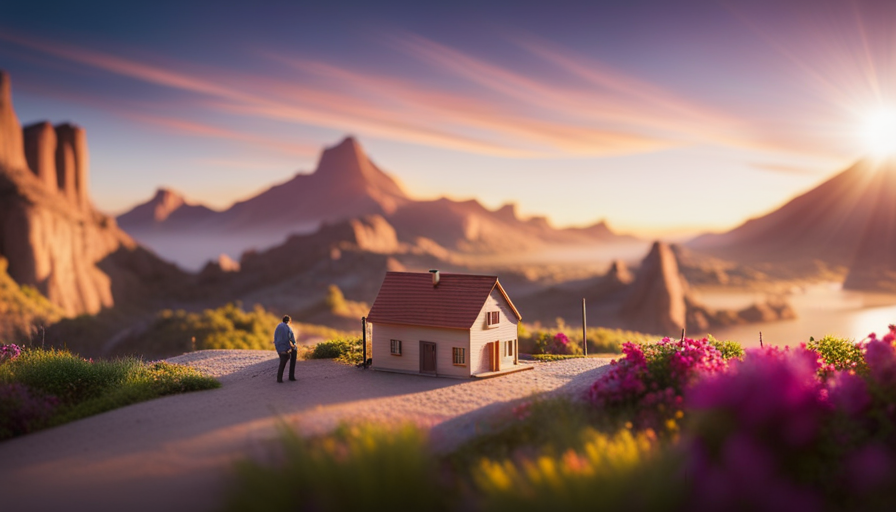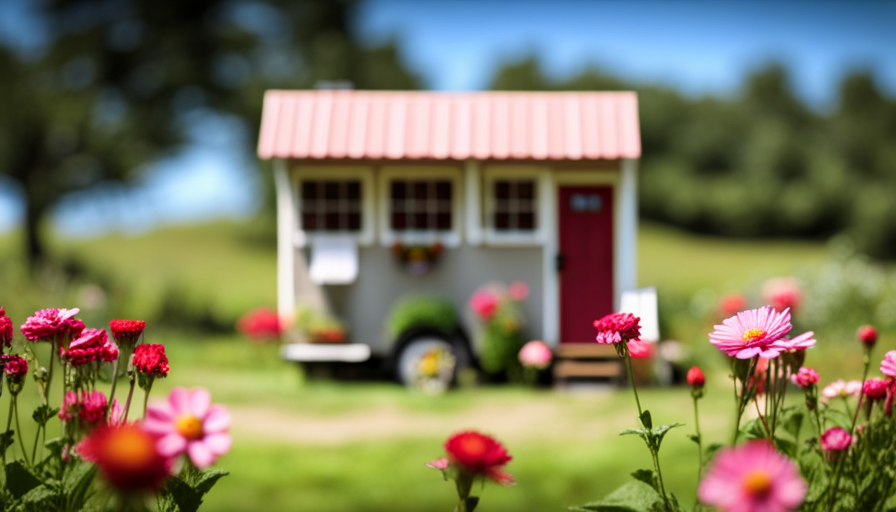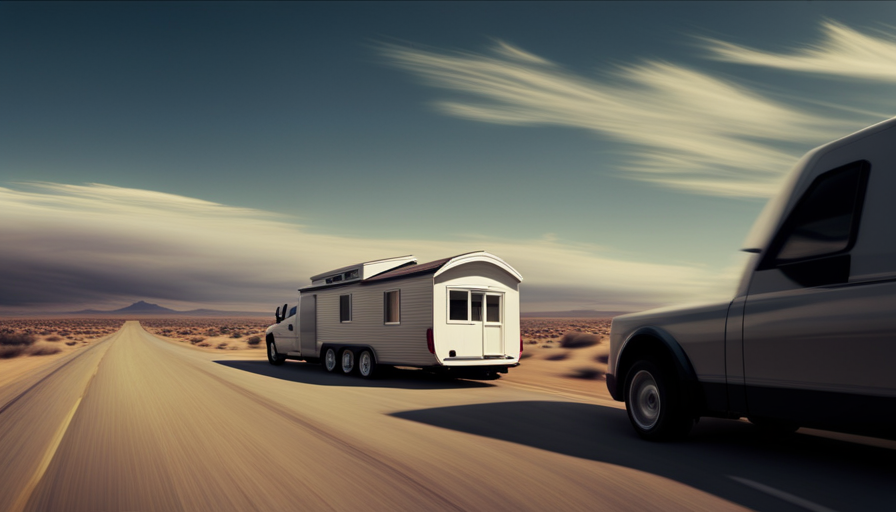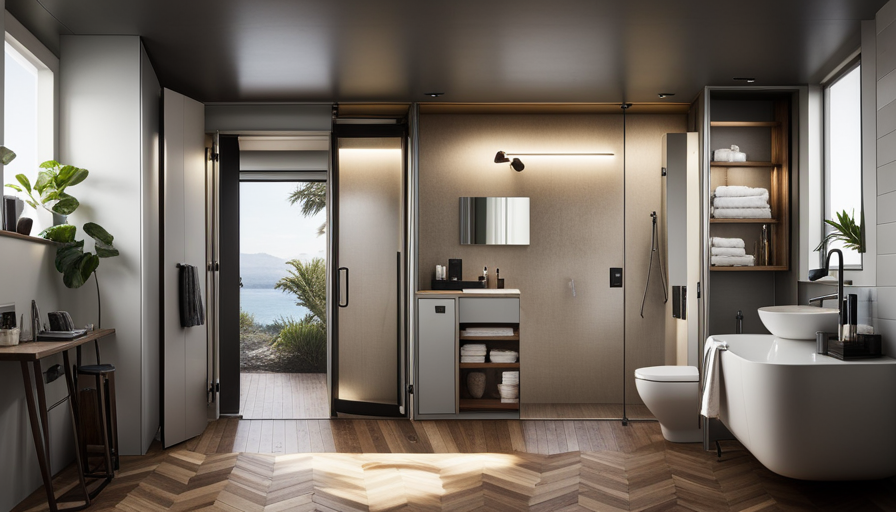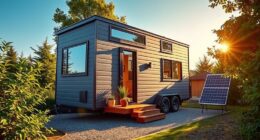In the realm of incredible architecture, there exists a unique group of brilliant minds who excel at creating small wonders that will leave you in awe. These innovators can be likened to contemporary wizards, transforming confined spaces into opportunities to showcase their intelligence and creativity.
They are the unsung heroes of the tiny house movement, crafting dwellings that defy convention and challenge our preconceived notions of what a home should be. With their imaginative designs and ingenious use of space, these architects have unlocked the secret to maximizing functionality without sacrificing style. From clever storage solutions to multifunctional furniture designs, they have revolutionized the way we live in compact spaces.
But it doesn’t stop there; these architects are also pioneers of sustainable design principles, ensuring that our tiny homes leave a minimal environmental footprint. Join me on a journey through the world of architects who design tiny houses, and discover the boundless possibilities that await within these humble abodes.
Key Takeaways
- Architects design tiny houses to maximize space and transform constraints into opportunities for innovation and creativity.
- Tiny houses challenge preconceived notions of what a home should be and revolutionize compact living.
- Sustainable design principles are emphasized in tiny houses, promoting minimalist design, eco-friendly materials, and efficient use of natural resources.
- Multifunctional furniture and clever storage solutions, such as transformable furniture and vertical storage, are crucial for maximizing space in tiny houses.
The Benefits of Tiny House Living
Living in a tiny house brings a multitude of benefits, making it an enticing choice for those seeking a simpler and more sustainable way of life. One of the primary advantages of downsizing to a tiny house is the opportunity to embrace a minimalist lifestyle. By reducing the amount of possessions and living in a small space, individuals can experience a sense of freedom and liberation from material possessions. This shift towards minimalism allows for a more intentional and mindful living, where one can focus on what truly matters and eliminate the unnecessary clutter that often accompanies larger homes.
Furthermore, living in a tiny house promotes a more sustainable lifestyle. With a smaller footprint, these homes require fewer resources to build and maintain. They consume less energy and produce less waste, making them environmentally friendly. Additionally, the reduced size encourages homeowners to adopt eco-friendly practices such as composting, rainwater harvesting, and utilizing renewable energy sources.
Moreover, the affordability of tiny houses is another significant benefit. Compared to traditional homes, tiny houses are much more cost-effective, both in terms of upfront costs and ongoing expenses. With lower mortgage payments, utility bills, and maintenance costs, individuals can allocate their financial resources towards other priorities, such as travel, savings, or pursuing their passions.
In the subsequent section about maximizing space with innovative designs, we will explore how architects are creatively designing tiny houses to optimize every inch of space and provide practical solutions for comfortable living.
Maximizing Space with Innovative Designs
By incorporating clever spatial arrangements and out-of-the-box concepts, these innovative minds are able to create homes that feel like a kaleidoscope of possibilities. Architects who design tiny houses have revolutionized the way we think about maximizing space. Through their innovative space-saving techniques and multi-purpose furniture designs, they have taken small living to a whole new level.
-
Transformable Furniture: One of the key elements in designing tiny houses is the use of transformable furniture. These creative pieces are designed to serve multiple functions, such as a sofa that can be converted into a bed or a coffee table that can be extended to become a dining table. By incorporating these versatile pieces, architects are able to maximize the functionality of every square inch.
-
Vertical Space Utilization: Another innovative approach is the use of vertical space. Architects are incorporating unique storage solutions that make use of the height of the room. From built-in shelves and cabinets to loft beds and hanging organizers, every nook and cranny is utilized effectively.
-
Hidden Storage: Architects are also incorporating hidden storage solutions into their designs. From secret compartments in the stairs to concealed drawers in the walls, these hidden storage spaces allow homeowners to keep their belongings organized without sacrificing precious floor space.
With these innovative designs, architects are proving that living in a tiny house doesn’t mean sacrificing comfort or style. Now, let’s explore the creative storage solutions for small spaces.
Creative Storage Solutions for Small Spaces
Make the most of your limited space with these creative storage solutions that will leave you amazed at how much you can fit in your small home. When it comes to living in a tiny house, maximizing every inch of space is crucial. Luckily, there are numerous space-saving furniture options and creative organizing techniques available that can help you make the most of your small living area.
One effective way to maximize storage is by incorporating multifunctional furniture. For example, a sofa that can also serve as a bed or a coffee table with hidden storage compartments can be a game-changer. These innovative designs allow you to have the functionality you need without sacrificing valuable space. Additionally, utilizing vertical storage solutions such as wall-mounted shelves, hanging organizers, and overhead cabinets can help you take advantage of unused wall space.
To give you a better idea of the possibilities, here is a table showcasing some popular space-saving furniture options and creative organizing techniques:
| Furniture | Function |
|---|---|
| Murphy Bed | Folds up into the wall during the day |
| Ottoman with Storage | Provides extra seating and hidden storage |
| Under Bed Storage | Utilizes the space under your bed for storage |
| Magnetic Spice Rack | Saves cabinet space by attaching to your refrigerator |
With these creative storage solutions and space-saving furniture, you can transform your tiny house into a functional and organized home. In the next section, we’ll explore functional and stylish furniture designs that will enhance the aesthetic of your small space seamlessly.
Functional and Stylish Furniture Designs
Experience the perfect blend of functionality and style with these furniture designs that’ll elevate the look of your small space. These functional and stylish furniture designs are specifically created to maximize space in tiny houses while still maintaining a modern and chic aesthetic.
Here are three space-saving design solutions that’ll transform your living area:
-
Convertible Sofa: This innovative piece of furniture serves dual purposes by functioning as a comfortable sofa during the day and transforming into a cozy bed at night. With its sleek design and hidden storage compartments, it’s the perfect solution for overnight guests in a limited space.
-
Wall-Mounted Shelving: Utilize your vertical space by installing wall-mounted shelves that not only provide additional storage but also add a decorative touch to your tiny house. These shelves can be used to display books, plants, or personal mementos, freeing up valuable floor space.
-
Folding Dining Table: A folding dining table is a practical and stylish addition to any tiny house. It can be easily folded and stored away when not in use, allowing you to maximize your floor space. When unfolded, it provides a functional and comfortable dining area for you and your guests.
These functional and stylish furniture designs are just the beginning of creating a well-designed and efficient tiny house. Next, we’ll explore sustainable design principles for tiny houses, ensuring that your small space isn’t only functional and stylish but also environmentally friendly.
Sustainable Design Principles for Tiny Houses
Transform your small space into an eco-friendly haven with sustainable design principles that prioritize the environment without compromising on style and functionality.
When it comes to designing tiny houses, minimalist design becomes essential. By adopting a minimalist approach, architects focus on maximizing efficiency and functionality while minimizing waste and unnecessary clutter. This design philosophy encourages the use of eco-friendly materials, which aren’t only sustainable but also contribute to a healthier living environment.
Incorporating eco-friendly materials into tiny house design is crucial to reduce the environmental impact. From reclaimed wood to recycled glass and natural fibers, there are numerous options available that promote sustainability. These materials don’t only add a unique aesthetic appeal to the space but also help reduce the carbon footprint. Additionally, they often require less maintenance and are more durable, making them ideal for tiny house living.
When designing a sustainable tiny house, it’s also important to consider the efficient use of natural resources. Incorporating natural light and ventilation is a key aspect of sustainable design. Large windows, skylights, and light-colored walls can help maximize natural light, reducing the need for artificial lighting during the day. Proper ventilation systems, such as strategically placed windows and vents, can help maintain a comfortable indoor environment while reducing the reliance on air conditioning.
By incorporating these elements, architects can create a space that isn’t only environmentally friendly but also promotes a healthy and inviting atmosphere.
Transitioning into the subsequent section about incorporating natural light and ventilation, these design principles go hand in hand with creating a sustainable and livable tiny house.
Incorporating Natural Light and Ventilation
Enhance your living space with an abundance of natural light and fresh air, creating a sustainable and inviting atmosphere. When designing a tiny house, architects who specialize in small space design understand the importance of incorporating natural light and ventilation techniques to maximize the comfort and livability of the space.
In order to make the most of natural light, architects employ various techniques such as strategically placing windows and skylights, using light-colored materials for walls and ceilings to reflect light, and utilizing open floor plans to allow light to flow freely throughout the space. These techniques not only make the tiny house feel more spacious but also reduce the need for artificial lighting during the day.
Ventilation is equally important in a tiny house to ensure a healthy and comfortable living environment. Architects employ various strategies to promote good airflow, such as incorporating windows that can be opened to allow cross ventilation, installing ceiling fans to circulate air, and using materials that allow moisture to escape, preventing the buildup of mold and mildew.
By incorporating these natural light techniques and ventilation strategies, architects create tiny houses that are not only energy-efficient and sustainable but also provide a bright and airy living environment. Transitioning into the subsequent section about customizing your tiny house to suit your lifestyle, these design principles can be tailored to meet your specific needs and preferences.
Customizing Your Tiny House to Suit Your Lifestyle
Personalize your compact living space to perfectly fit your unique lifestyle and preferences. When designing a tiny house, there are numerous customizing options to consider that will enhance both the functionality and aesthetics of your home.
One of the most important aspects to focus on is the interior layout. Here are three key customizing options that will allow you to create a tiny house that truly reflects your personality and needs:
-
Multi-purpose furniture: Maximize your space by incorporating furniture that serves multiple functions. Think about investing in a sofa that can transform into a bed or a table that can fold down when not in use. These versatile pieces will optimize the limited square footage and provide convenience.
-
Storage solutions: Efficient storage is essential in a tiny house. Consider installing built-in shelves, cabinets, and drawers to maximize vertical space. Additionally, utilizing hidden storage compartments, such as under-bed drawers or staircase cubbies, can help keep your belongings organized and out of sight.
-
Personal touches: Add your personal touch to your tiny house by incorporating design elements that resonate with you. Whether it’s using a specific color palette, displaying artwork, or incorporating sentimental objects, these small details will make your tiny house feel like a home.
Now that you have learned about customizing your tiny house to suit your lifestyle, let’s explore budget-friendly tips for building a tiny house.
Budget-Friendly Tips for Building a Tiny House
Save money while building your compact living space by utilizing cost-effective strategies and resources. When it comes to constructing a tiny house, there are several budget-friendly tips that can help you save on expenses without compromising on quality.
One of the most significant ways to cut costs is by carefully choosing your building materials. Opt for affordable yet durable options such as reclaimed wood or recycled materials. These not only reduce expenses but also contribute to sustainability efforts.
Additionally, consider investing in energy-efficient systems that can further lower your utility bills in the long run. Incorporate features like solar panels, LED lighting, and insulation to maximize energy efficiency and minimize costs.
Furthermore, sourcing materials locally can also help in reducing transportation costs. Look for nearby suppliers or salvage yards that offer affordable options.
Another way to save money is by taking on some of the construction work yourself. If you have the necessary skills and time, you can tackle certain tasks like painting, tiling, or installing fixtures, which can significantly reduce labor costs.
Finally, consider joining online communities or attending workshops where you can learn from experienced tiny house builders and gain valuable insights.
By implementing these budget-friendly strategies, you can build your dream tiny house without breaking the bank.
Now let’s explore some inspiring examples of tiny house architecture that showcase the creativity and innovation of architects in this field.
Inspiring Examples of Tiny House Architecture
Indulge in a little daydreaming as you marvel at the remarkable feats of ingenuity showcased in these captivating examples of pint-sized dwellings. Architects who design tiny houses have truly pushed the boundaries of creativity and functionality, resulting in innovative tiny house designs that are both aesthetically pleasing and practical.
One example of a unique tiny house design is the ‘Hobbit House’ by architect Vina Lustado. This tiny dwelling is inspired by the hobbit homes from J.R.R. Tolkien’s books and features a curved roof made of reclaimed wood, giving it a whimsical and organic feel.
Another notable example is the ‘Ecocapsule’ by Nice Architects, which is a self-sustainable micro home that can be placed anywhere. It incorporates solar panels and a rainwater collection system, making it an environmentally friendly option.
In addition to innovative designs, architects have also utilized unique materials in tiny house construction. For instance, the ‘Bamboo House’ by architect Simon Velez is constructed entirely out of bamboo, showcasing the versatility and strength of this sustainable material.
Another example is the ‘Container House’ by architect Adam Kalkin, which repurposes shipping containers to create a modern and minimalist living space.
As these inspiring examples demonstrate, architects who design tiny houses have truly pushed the boundaries of what’s possible in small space living. Transitioning into the future of tiny house living, it’s clear that these architects will continue to explore new materials and designs, creating even more innovative and sustainable dwellings.
The Future of Tiny House Living
Imagine living in a world where minimalist, sustainable dwellings redefine the concept of home, offering a refreshing escape from the chaos of modern life. Tiny houses are revolutionizing the way we think about living spaces, and their future is bright.
However, living in a tiny house comes with its own set of challenges. Firstly, space can be a major constraint. With limited square footage, it requires careful planning and organization to make the most of every inch. Storage solutions, multifunctional furniture, and creative design ideas are essential to maximize the living experience.
Secondly, living in a tiny house can have a significant impact on social interactions. While some individuals thrive in smaller communities, others may find it challenging to adjust to a more intimate and communal lifestyle. However, the tiny house movement has fostered a strong sense of community among its residents, with shared spaces and activities creating opportunities for connection and support.
Lastly, zoning regulations and legal considerations can pose hurdles for those wishing to embrace the tiny house lifestyle. Many cities and towns have strict regulations regarding minimum square footage and permanent dwellings, making it difficult to find suitable locations for tiny houses.
While tiny house living offers a unique and sustainable way of life, it’s not without its challenges. From space constraints to social dynamics and legal obstacles, navigating the world of tiny houses requires careful planning and a strong sense of community. Despite these challenges, the future of tiny house living looks promising, as more architects and designers continue to innovate and create inspiring solutions for minimalist and sustainable living.
Frequently Asked Questions
What are the most popular materials used in building tiny houses?
The most popular materials used in building tiny houses are sustainable options like reclaimed wood and recycled metal, which not only add character but also contribute to a greener environment. These cost-effective choices make tiny houses eco-friendly and budget-friendly.
How do architects ensure that tiny houses are structurally sound and safe?
To ensure structural integrity and safety measures in tiny houses, architects use various techniques. They carefully design the layout, select appropriate materials, and reinforce key areas like the foundation and framing. Additionally, they adhere to building codes and conduct thorough inspections.
Are there any building codes or regulations specific to tiny houses?
Building codes and zoning regulations vary by location, but there are generally requirements for tiny houses. These codes ensure that the structures are built safely, with consideration for things like minimum square footage, ceiling height, and safety features.
How do architects incorporate privacy into the design of tiny houses?
Privacy considerations are crucial in tiny house design. Architects optimize space by strategically placing walls, using sliding doors, and incorporating curtains or blinds. These design elements create separate areas within the limited space, ensuring privacy for the occupants.
What are some common challenges faced by architects when designing tiny houses?
Designing tiny houses presents architects with challenges such as design flexibility and space optimization. These professionals must creatively maximize limited square footage while ensuring functionality and comfort. It requires careful planning and innovative solutions to overcome these obstacles.
Conclusion
In conclusion, architects who design tiny houses have truly revolutionized the way we think about living spaces. They have maximized space with innovative designs and utilized creative storage solutions, transforming small spaces into functional and stylish homes. These architects have also shown a commitment to the environment by incorporating sustainable design principles. Customization options allow individuals to create a tiny house that suits their unique lifestyle. With budget-friendly tips and inspiring examples of tiny house architecture, the future of tiny house living looks incredibly promising.
Coincidentally, this trend aligns with the growing desire for simpler and more sustainable living.
Hi, I’m Emma. I’m the Editor in Chief of Tiny House 43, a blog all about tiny houses. While tree houses are often associated with childhood, they can be the perfect adult retreat. They offer a cozy space to relax and unwind, surrounded by nature. And since they’re typically built on stilts or raised platforms, they offer stunning views that traditional homes simply can’t match. If you’re looking for a unique and romantic getaway, a tree house tiny house might just be the perfect option.
